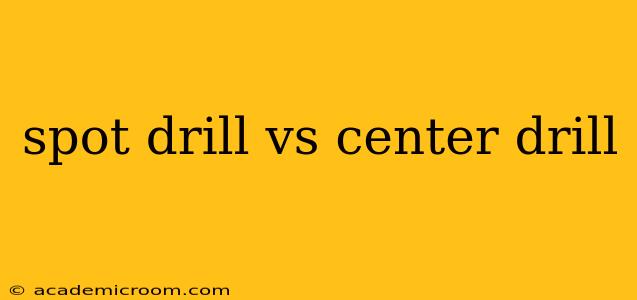Choosing between a spot drill and a center drill can be confusing, as both tools seem to serve a similar purpose: creating a starting point for drilling. However, there are key differences in their design, application, and resulting hole characteristics that determine which tool is best suited for a particular job. This comprehensive guide will clarify these distinctions, helping you make informed decisions for your machining projects.
What is a Spot Drill?
A spot drill is a specialized drill bit with a blunt, conical tip and typically a much shorter cutting length than a center drill or standard drill bit. Its primary function is to create a shallow, slightly countersunk indentation, precisely locating the center point for a subsequent larger drill bit. This precise centering prevents the larger drill bit from wandering during the initial stages of drilling, crucial for achieving accurate hole placement and preventing damage to the workpiece.
What is a Center Drill?
A center drill, in contrast, is a two-part tool. It comprises a conical point similar to a spot drill, but it also features a shorter, slightly angled cutting section below. This design allows it to create a deeper, more defined pilot hole, essentially pre-drilling the material before the larger drill bit is used. The pilot hole acts as a guide, similar to the spot drill's indentation, but it also provides a small degree of material removal, leading to a more controlled drilling process for larger holes.
Spot Drill vs. Center Drill: Key Differences Summarized
| Feature | Spot Drill | Center Drill |
|---|---|---|
| Tip | Blunt, conical | Conical with angled cutting section |
| Hole Depth | Shallow indentation | Deeper pilot hole |
| Material Removal | Minimal | Moderate |
| Purpose | Precise center location | Precise center location & pilot hole creation |
| Accuracy | Excellent for accurate hole placement | Excellent for accurate & smoother drilling |
| Applications | Small diameter holes, delicate materials | Larger diameter holes, thicker materials |
What are the Applications of a Spot Drill?
Spot drills shine when precision is paramount and the material is relatively soft or delicate. Their shallow indentation provides a pinpoint starting point for the main drill bit, minimizing the risk of the larger bit wandering, which is especially important in:
- Precise location of holes: When precise hole placement is critical, a spot drill minimizes any drift of the larger drill.
- Delicate materials: The minimal material removal reduces the chance of damaging or cracking fragile workpieces.
- Thin sheets: Prevents blowout on the exit side when drilling through thin materials.
What are the Applications of a Center Drill?
Center drills are preferred when a more substantial guide is needed, primarily due to their deeper pilot hole. This makes them suitable for:
- Larger diameter holes: The pre-drilled hole acts as a guide preventing wandering with larger drills.
- Thicker materials: The deeper hole facilitates easier drilling and reduces the strain on the larger drill bit.
- Improved surface finish: The pre-drilling action of the center drill can lead to a cleaner hole and improved surface quality.
Which one should I use?
The choice between a spot drill and a center drill depends largely on your project's specifics:
-
For extremely precise hole placement in delicate materials, particularly with small diameter drills, a spot drill is the better option. Its minimal material removal minimizes the risk of damage.
-
For larger diameter holes, thicker materials, or situations where a smoother, more controlled drilling process is desired, a center drill is the preferred choice. The deeper pilot hole acts as a better guide and eases the drilling process.
How do you use a spot drill and a center drill?
Both tools are used in a standard drilling process. The drill is held securely, placed on the marked center point of the workpiece, and then driven into the material at a controlled speed. Remember to always use appropriate speed and feed rates based on the material being drilled and the diameter of the drill bit. Lubrication is also often beneficial.
This guide provides a comprehensive understanding of the differences between spot drills and center drills. By carefully considering the factors discussed above, you can select the right tool for your specific machining needs and ensure consistent, accurate results.
